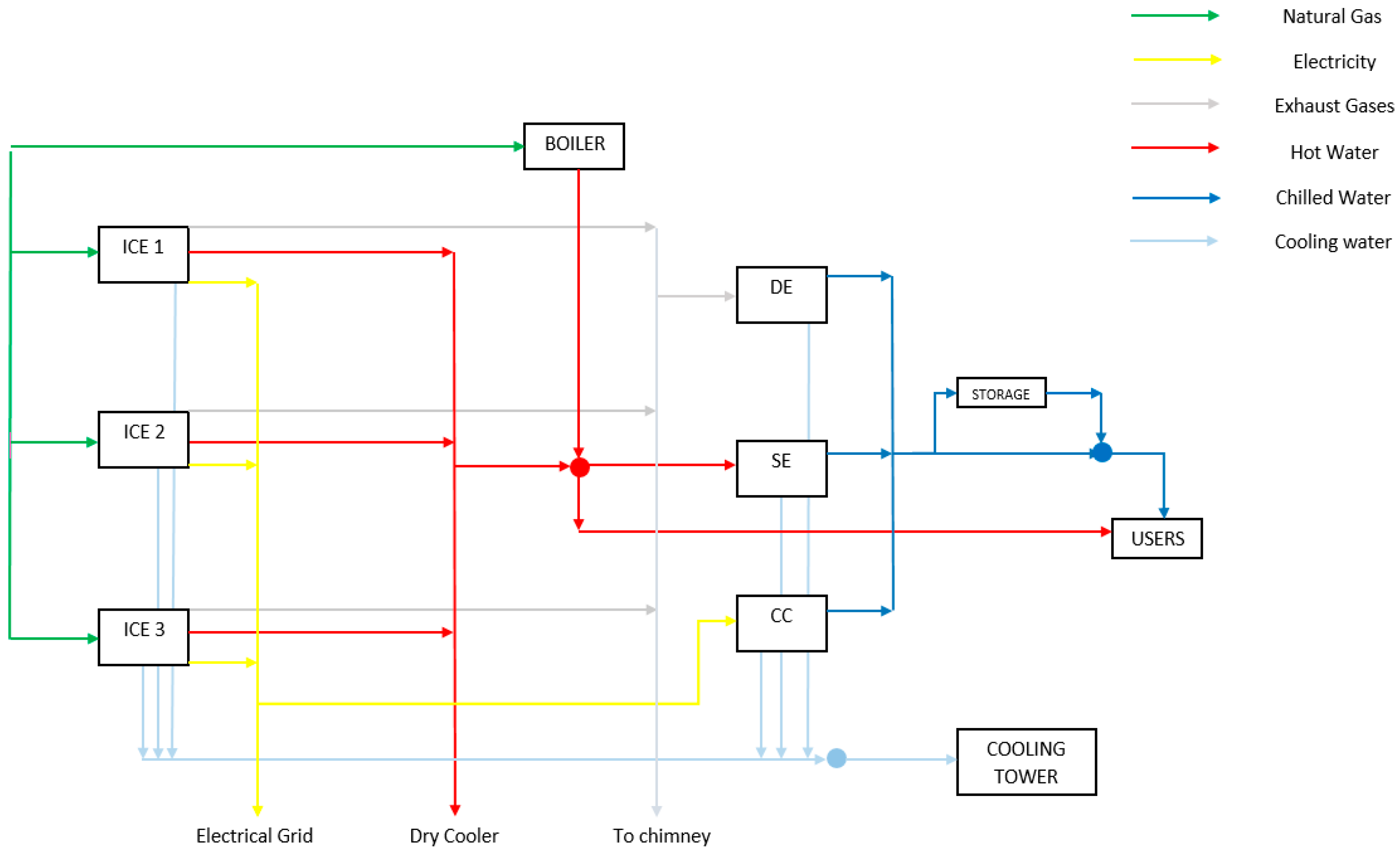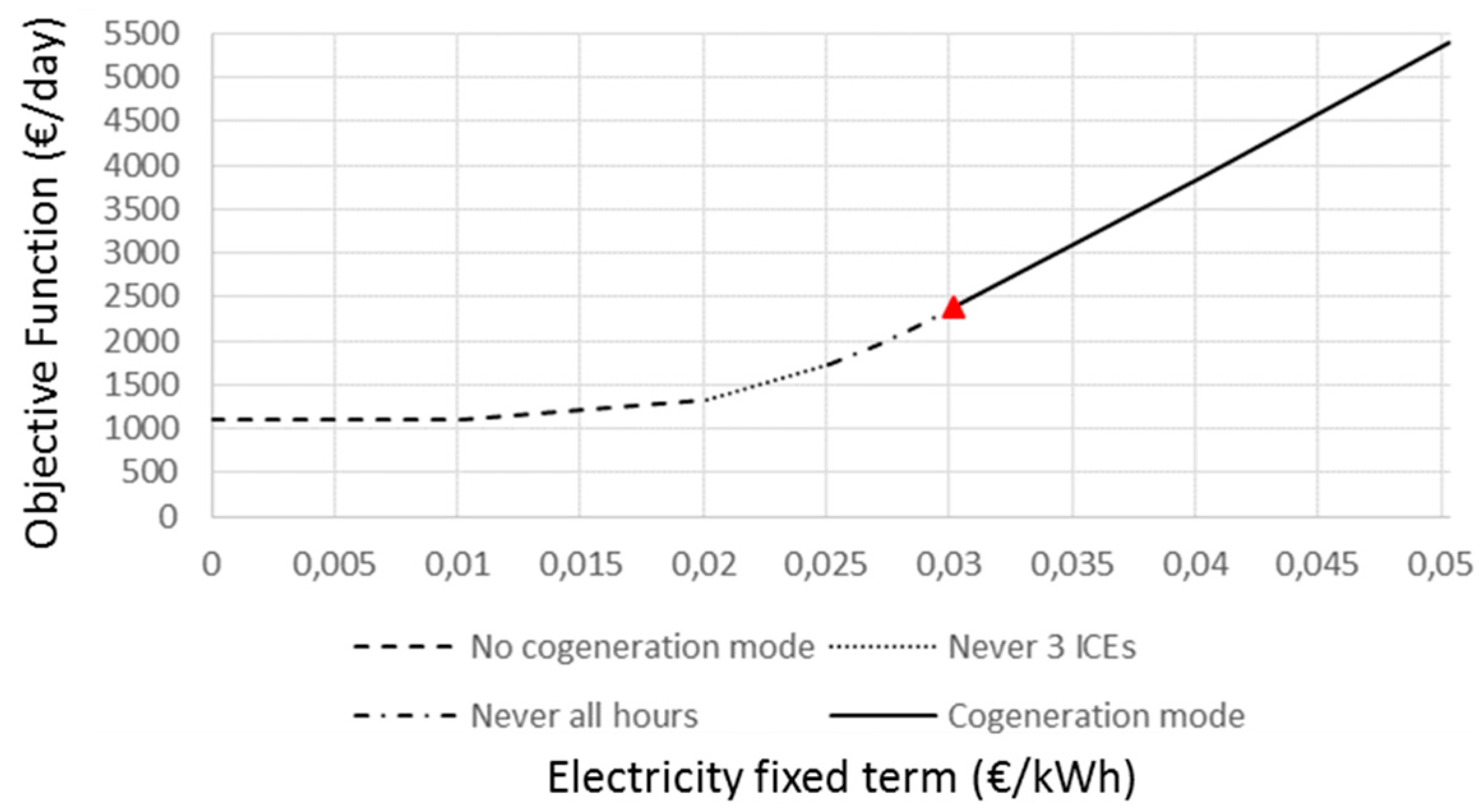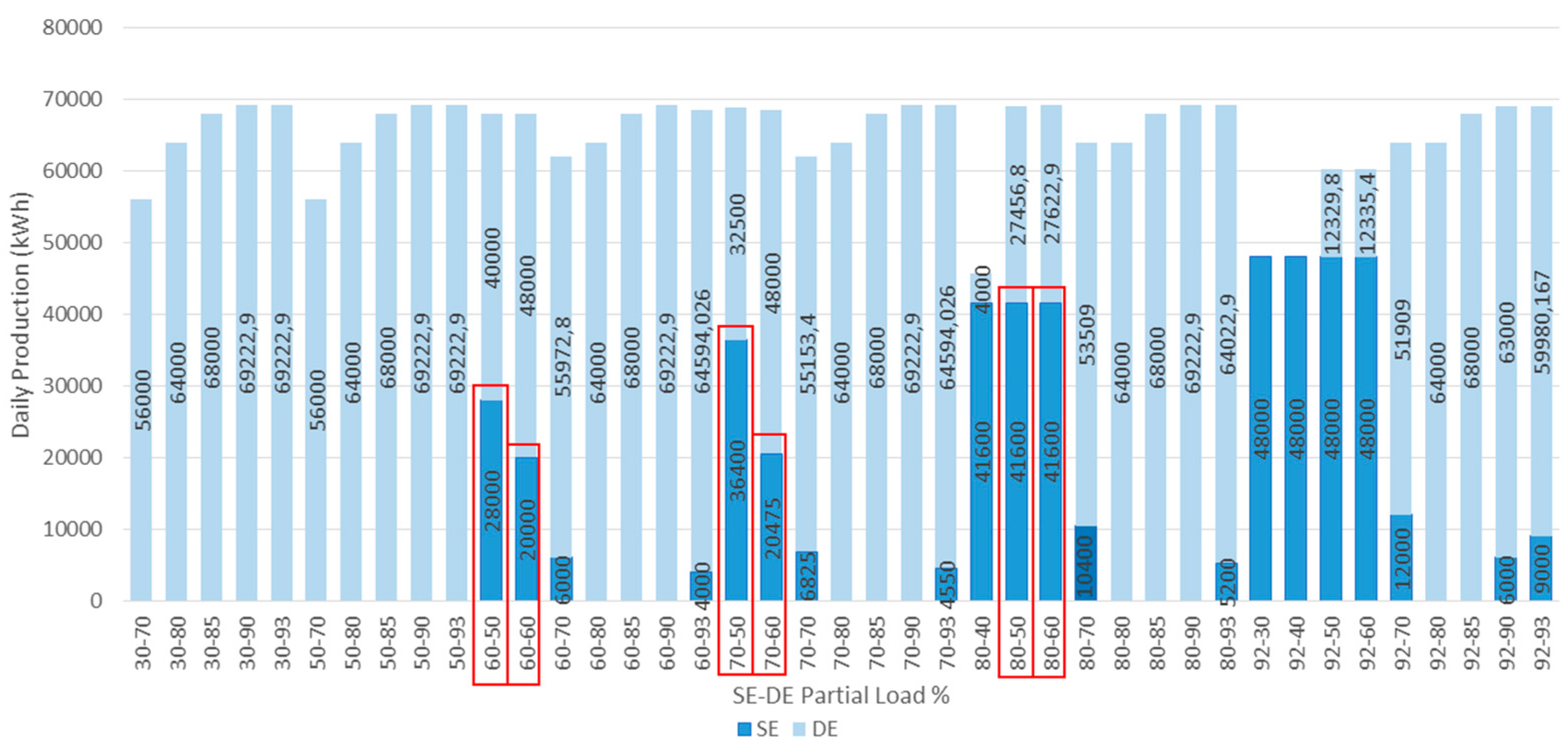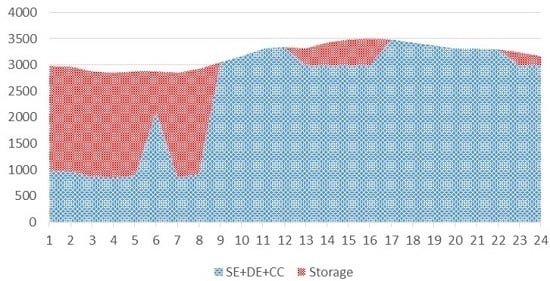1. Introduction and Objectives
Trigeneration plants integrated into district heating and cooling (DHC) networks are a very efficient way to provide energy services with the exploitation of locally generated waste heat to produce heating and cooling in a very efficient way and delivering them to final users. In this way the users benefit from a scale factor with respect to the efficiency of the energy supply systems, avoid the cost of maintenance and save precious space in their facilities as the main advantages. Other more general and very important benefits are related with the saving of primary energy and lower environmental impact [
1]. In many cases the deployment of DHC networks is not as fast as initially planned at the design stage of the project because the number of consumers connected to the DHC increases at a slower pace than expected. Trigeneration plants connected to DHC networks are designed to operate in several modules of cogeneration engines that can be connected and disconnected to the system to account for this type of problems and the variability of the users demand. In many cases, modularity and flexibility of modern and efficient trigeneration plants is not enough to properly work at the very low partial load when serving the DHC during the first stages of the implementation of the project [
2]. A low load of the plant can lead to low energy efficiency.
Additionally trigeneration plants can use different types of units, typically single effect and double effect absorption chillers, vapor compression chillers and cooling storage systems. The variable cooling load demand of the buildings connected to the DHC has to be distributed among these chillers to achieve lower operating costs and higher energy efficiencies. This problem is even more difficult to solve taking into account the different partial load behavior of each chiller and the high number of possible unit combinations that can cover a given demand specially with the appropriate dimensioning of the cooling storage.
The distribution of the load or “load sharing” should not be confused with the load sharing concept also used in the literatures [
3,
4] that refers to a system with a thermal and/or cooling load from a diversified type of end users (residential and commercial users and different types of industries). This last definition could be regarded as an “external load sharing”. In this case the overlapping of the load demand is interesting to increase the trigeneration plant efficiency due to a higher number of annual operation hours. Piacentino et al. [
5] presented one of these cases where a comprehensive tool is presented for the optimization of polygeneration systems serving a group of different types of buildings.
Another concept is the “internal load sharing” inside of the trigeneration plant between the units providing the same type of utility, electricity, heating or cooling. This last concept is of special interest to develop the load-sharing strategy to maximize the aggregate performance [
6]. In this paper both external and internal load sharing will be considered but only the internal cooling load sharing will be studied.
Usually, multiple-chillers systems are controlled using a sequential approach to provide the building load demand [
7]. Since the flow of chilled water in each chiller is constant and the chilled water temperature provided by each chiller has to be the same, they have to operate at the same part load ratio. Instead of this it could be interesting to study other sharing load strategies. Abou-Ziyan and Alajmi [
6] analysed the load sharing effect in multiple reciprocating compression chillers and sharing the load between the four compressors that equipped each compression chiller. It was reported a performance improvement between 22% and 33% with respect to the same part load ratio distribution strategy. Yu and Chan [
8] studied the load distribution between chillers of equal or different sizes. They propose to use the maximum load in one of them and the other running at partial load. In the case of different sizes, the biggest one should be kept at full capacity and the other one will follow the load. These preliminary strategies can be used applied in compression chillers but are not of direct application for absorption chillers that are not only affected by their own partial load characteristics, ambient conditions and variability of the load demand but also by additional effects, such as the characteristics of the waste heat use to drive the system. Underwood et al. [
9] studied the simultaneous chilled water demand distribution between a single effect absorption chiller and a compression chiller in a theoretical case study. The conclusion was that this arrangement could be of interest when the power demand is lower than the rated capacity of the cogeneration plant and the cooling demand is high. Energy costs were not considered in this study.
Many studies have been carried out such as Hajabdollahi et al. [
10], Chicco and Mancarella [
11] and Stojiljkovic et al. [
12], just to mention a few, to optimize the operation and/or design of trigeneration plants using partial load characteristics and different optimization approaches and objectives [
13] including in some cases thermoeconomic and exergy analysis [
14] or environmental information obtained through life cycle analysis techniques incorporated into the optimization model [
15]. In some cases the main interest is focused in the design of new trigeneration systems for DHC networks for different cases such as big urban areas [
16], for small scale applications with the integration of renewable energy sources [
17] or to study the combined effect of optimized energy supply systems and reduction of home energy demands [
18]. Many of all these studies include operational optimization but are more focused on the design because the partial load behaviour of the units is generic and do not correspond to any specific equipment. Then, no distinction can be made on different types of thermal chillers.
However, the number of studies in literature based on real data from trigeneration plants connected to a DHC is very scant. Thus it is clear that the current literature lacks empirical or operational data to validate thermodynamic models of integrated systems with multiple components [
9,
13]. Also there is no information on the actual energy efficiency of trigeneration plants working at low partial load. Even the information on the performance at partial load of some key components such as absorption chillers is more limited that it could be expected. The abundant information available comes mainly from manufacturer’s data or laboratory tests of low capacity chillers [
19,
20,
21] instead of on-site field measurements during plant operation.
So far the load sharing optimization has not been studied for a combination of different types of chillers (thermally driven and compression chillers) and connected to a cooling storage. This paper presents a mixed integer linear programming (MILP) model of a trigeneration plant based on cogeneration engines. MILP has been proposed and utilized widely as one of the most effective optimization approaches for this type of problems [
22,
23]. It leads to a natural expression of decision variables. For example, the selection, number, and on/off status of operation of equipment are expressed by integer variables and the capacities and load allocation of equipment by continuous ones. This model is used to optimize the daily plant operation and to study the optimal cooling load sharing between the different types of absorption chillers, compression chillers and cooling storage. The main parameter to compare load distribution configurations will be the primary energy saving. The heat of the exhaust gases is recovered to produce cooling in a double effect chiller and the engine cooling waste heat is used to drive a single effect absorption chiller. A high efficiency compression chiller is used as a back-up system. The system uses also a chilled water storage tank. Real data from a trigeneration plant connected to a DHC close to Barcelona (Spain) is used for the development of the model. A second objective of the paper is to study the efficiency of this type of trigeneration plants working at cooling load demands lower that 50% of its nominal capacity.
2. Description of the Trigeneration Plant
In the framework of the Polycity project [
24] a high efficiency energy polygeneration plant was implemented in a new urban development called Parc de l’Alba in Cerdanyola del Vallès (Barcelona, Spain). This area includes a science and technology park with a Synchrotron light facility called ALBA as well as other low energy consumption buildings. This project was executed in several stages. In a first stage, it was built a trigeneration plant known as ST-4 based on cogeneration engines. In the next stages of the project is expected to increase the number of engines and chillers in service and probably the integration of renewable energy sources. Ortiga et al. [
2] presented the initial design of this new plant under different scenarios (development stages, integration of renewables, costs, etc.). The CREVER research group at the Universitat Rovira i Virgili in Tarragona (Spain) is monitoring this trigeneration plant in order to evaluate its performance using current operation data and propose new operation strategies and possible energy saving measures. The process data analysed corresponds to the energy production in summer 2014.
2.1. Main Components
The ST-4 plant provides electricity, hot and chilled water for a synchrotron light facility and other buildings which belong to the Science and Technology Park called Alba Park using a four pipe DHC network.
Figure 1 shows the system configuration with their main components and energy streams. The main customer of the DHC network is the ALBA synchrotron light source facility that includes the laboratory and office building. The nominal capacity required is 8750 kW and 1400 kW for cooling and heating, respectively. This facility requires cooling at 7.0 ± 0.5 °C for heating, ventilation and air conditioning (HVAC), Deionized water at 23.0 ± 0.2 °C to remove the heat load from the synchrotron light source, and hot water at 50.0 ± 1 °C and operates more than 5000 h/year considering the maintenance activities. Therefore, the demand of cooling and heating from the trigeneration plant is guaranteed.
The main units of the plant are three turbocharged cogeneration engines (JMS 620 GS-N.L, GE Jenbacher GmbH & Co., Jenbach, Austria) with intercooler based on the Miller cycle, and a unitary electrical nominal capacity of 3354 kW and 3102 kW of total thermal energy if the exhaust gases are cooled down to 120 °C. The nominal electrical efficiency is 45% and the global thermal efficiency is 86.5%. The exhaust gases of these engines are used to drive a 5 MW series flow double effect water/LiBr ED 80C CX absorption chiller (Thermax Limited, Chinchwad, India). This chiller has a two stage evaporator (twin design concept) that produces a higher temperature difference in the chilled water in order to reduce the mass flow circulation and at the same time increases the coefficient of performance (COP). The heat recovered from the jacket cooling system of the cogeneration engines is used to drive a 3 MW single effect absorption chiller (Thermax LT 105T) based on the twin design concept. A twin design of the low pressure components evaporator/absorber and the high pressure components generator/condenser are of interest to cope with a large temperature difference between the inlet and outlet of the external heat carriers [
25] as is the most suitable situation in chillers connected to DHC networks. It is also interesting for the chiller capacity regulation because it depends not only on the temperature of the external heat sources but also on their temperature difference [
26].
Chilled water can be produced also using a 5 MW 19XR 8587 compression chiller (Carrier Co., Syracuse, NY, USA) equipped with a hermetic centrifugal compressor and a variable speed drive. A natural gas fired-tube boiler of 5 MW is available as backup for heating. There is also a chilled water storage of 4000 m
3 to deliver about 7 MW of cooling during 2.5 h for a temperature difference of 6 °C. The interested reader can refer to Ortiga et al. [
2] for a more detailed description of the plant and the performance of their components in nominal conditions.
2.2. Monitoring System
The entire system is monitored and controlled by sensors of temperature, flow rate and thermal energy meters. A data acquisition system has been connected to the supervisory, control and data acquisition (SCADA) system of the ST-4 plant to collect specific data of interest for the energy analysis of the plant. The process variables are registered each minute and stored. Nowadays data acquisition system can record multiple variables in short sampling times. As result, the volume of information available is very large and it might be difficult to calculate mass and energy balance. These balances may not be met due to: random and gross errors in the measurements, deviations from steady state, redundancy in the measurements, etc. Therefore the methodologies used for the data treatment should generate a coherent set of measurements so the performance of the absorption chillers can be reliably estimated [
21].
2.3. Monitored Data and Operation Schedule
The most singular units in the plant for its special design (
Section 2.1) are the two absorption chillers.
Table 1 and
Table 2 show some stationary working conditions for both chillers in different dates.
All the variables correspond to the external circuits because there is no information on internal parameters as it is the usual situation for industrial applications. Each column corresponds to a certain period for one day. The first column of data (NC) refers to the values of the same unit at nominal conditions to compare with the working conditions of a certain period of day. Q losses correspond to the discrepancy in the global energy balance of the unit due to usual deviation in steady-state, measuring instruments, etc. The main lessons that could be extracted from these data is the capacity of the chillers to work well below its nominal capacity and the wide temperature of the hot water and exhaust gases used to drive the chillers. The data presented in
Figure 2 and
Figure 3 show that the COP of the single- and double-effect chillers is reasonably acceptable in spite of the low cooling load of the plant, between 0.6–0.65 and close to 1, respectively for a load around 40% of its nominal capacity.
Typically during weekdays the three engines are running at full capacity, from 8 h to 23 h, to take advantage of high price of electricity during this period. Some weeks in July and August only two engines produce electricity because of the decrease in the energy demand. During the night and weekends are usually out of service also due to the low price of electricity in these periods.
The required thermal energy for the DHC network during the weekend is supplied by the gas boiler. In emergency cases the heat provided by the boiler could substitute one of the engines if required. However, the thermal chillers are only working when the engines are in operation. In this period, the chilled water storage is in recharge mode.
The present demand of chilled water in summer is covered by the single- and DE absorption chillers at partial load (usually not higher than 50%). During the night (approximately from 23 h to 8 h) and weekend periods the cooling demand is covered using the compression chiller and the cooling storage system. During the night, the preferred system is the cooling storage and during the weekend is the compression chiller.
3. Modelling
The mathematical programming optimization model was developed using general algebraic modelling system (GAMS) with the solver Cplex. The model is able to optimize the operational strategy for a typical day using a MILP approach. The binary variables are used to indicate when a given unit is in operation or not, o when the storage tank changes its operation mode. The objective function (Equation (1)) is the difference between the income to the plant (Equation (2)) and the operational (Equation (3)) and maintenance costs. In this model
i stands for a given unit and
j is the time period (one hour). Electricity sold to the grid is calculated through the balance presented in Equation (4),
CCEl is the electricity for the compression chiller,
CTfans for the cooling tower fans,
ElDryCooler for rejecting heat from the engines cooling system,
Elpumps for all the plant pumps and
Elventilation for the rejection of heat from the engines’ rooms. This last value has been considered to be of 74 kW per engine in operation:
3.1. Engines Constraints
Equations (10) and (11) are useful to avoid continuous ON-OFF of the engines and impose at least two hours of continuous working. Equivalent constraints are applied for the other units: boiler and absorption and compression chillers.
3.3. Double Effect Absorption Chiller Constraints
3.4. Single Effect Absorption Chiller Constraints
3.5. Compression Chiller Constraints
3.6. Storage System Constraints
3.7. Cooling Tower Constraints
where in Equation (50), 10 is the assumed difference of temperatures between the input and output air in the tower, 25 °C is a typical temperature for the make-up water and Δ
w is the difference in specific humidity at the inlet and outlet air streams.
Table 3 shows the estimated power for each pump of the system.
The days selected for the analysis include weekdays and weekend days. The required inputs are the hourly demand for each day and some parameters such as the price of electricity, heating and cooling sold to the DHC end users, nominal capacity of each unit, maintenance costs, etc. The considered cost of natural gas is 30.2 €/MWh. The price of the electricity fluctuates along the day and has two contributions, a fixed and a variable cost. Some restrictions are added to the model to avoid continuous on-off of the same unit. The partial load performance of each unit has been modelled using the plant operational data and the nominal performance provided by the manufacturer. The assumed maintenance costs for the cogeneration engines, thermal chillers, compression chiller, boiler and storage system are 20 €/h, 6 €/h, 15 €/h, 0.3 €/h and 15 €/h, respectively.
The trigeneration primary energy savings (PES) indicator (Equation (52)) is used to compare the different operational configurations. A crucial point in the numerical assessment of the primary energy saving is the merit of assigning suitable values to the reference efficiencies, which, in general, will depend on the technologies replaced. There are no official guidelines for this kind of reference efficiencies. In the following analysis intermediate efficiency values have been assumed, in particular: electrical efficiency was set equal to 0.45, thermal efficiency to 0.95 and the COP of the compression chiller equal to 5:























